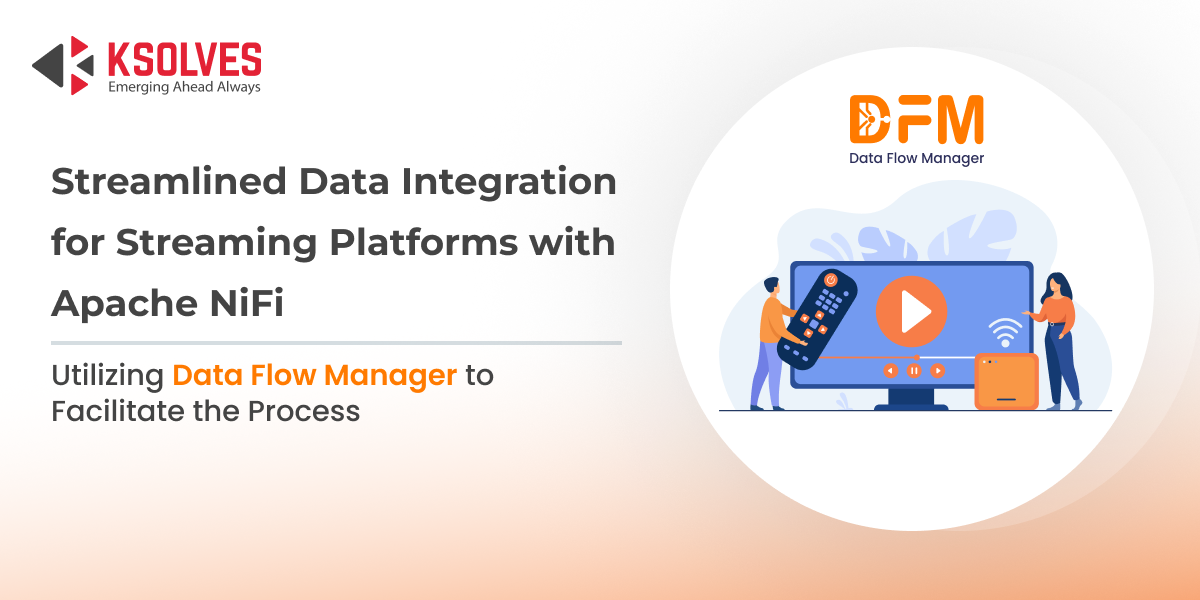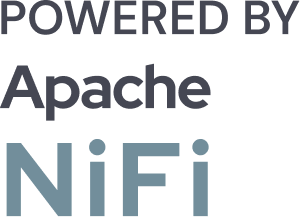How Does Apache NiFi Streamline Data Integration for Streaming Platforms?
![]()

In today’s hyper-connected world, the appetite for digital content is insatiable. Whether it’s binge-watching a new series on Netflix, listening to trending podcasts on Spotify, or attending a live concert on Twitch, users expect instant, personalized, and high-quality experiences. What fuels this immersive experience isn’t just creative content — it’s data.
Behind every play, pause, like, and share lies an intricate network of data pipelines that power personalization engines, monitor performance, and guide business decisions. Streaming platforms process terabytes to petabytes of data daily. But with great data comes great complexity.
This is where Apache NiFi becomes a game-changer — a robust, low-code, flow-based data integration tool that can tame the chaos and bring clarity to data workflows.
Data Integration Challenges in Streaming Platforms
Modern streaming platforms are not just content delivery systems. They are real-time data factories. They collect and process vast amounts of data every second, including:
- User interaction logs (e.g., watch time, skip, search queries)
- Device and platform metadata (browser, OS, location)
- Third-party API calls (recommendation engines, sentiment analysis)
- Content Management Metadata (title, description, tags)
- Performance metrics (buffering rate, error logs, bandwidth)
Integrating this data in real time, across diverse sources and formats, poses major challenges:
1. Volume and Velocity
According to Netflix, users watch more than 100 million hours of content per day. Each action generates a trail of data — interactions that must be tracked, processed, and analyzed without delay.
2. Variety and Complexity
Data doesn’t come neatly packaged. You have structured data (SQL databases), semi-structured (JSON from APIs), and unstructured content (text, audio transcripts). Creating unified views requires heavy data wrangling.
3. Latency Expectations
In a competitive landscape, delivering personalized content in milliseconds is crucial. The window to recommend the next show or suggest a relevant playlist is incredibly small.
4. Compliance and Data Governance
Regulations like GDPR and CCPA require platforms to secure user data, track its lineage, and ensure proper access controls.
Traditional ETL tools fall short in handling this real-time, diverse, and sensitive data at scale.
Apache NiFi: The Best Choice for Data Integration in Streaming Platforms
Apache NiFi offers a refreshing alternative. Built originally for the NSA and later open-sourced by the Apache Foundation, NiFi provides an intuitive, drag-and-drop interface to create powerful data flows without writing boilerplate code.
What Makes NiFi Ideal for Streaming Platforms?
- Visual Flow-Based Programming: Design data pipelines visually using 300+ pre-built processors.
- Real-Time Processing: Ingest, filter, transform, and route data in real time.
- Data Provenance: Audit every change, every movement — essential for compliance.
- Scalable & Cluster-Ready: Handle data spikes by deploying in a clustered environment.
- Secure by Design: Built-in support for SSL, OAuth, and fine-grained access controls.
How Apache NiFi Helps in Data Integration for Streaming Platforms
1. Real-Time Data Ingestion
NiFi can ingest data from a wide range of sources simultaneously — mobile apps, web browsers, backend servers, CDN logs, APIs, and third-party services. Its processors are capable of pulling in data using protocols like HTTP, Kafka, MQTT, SFTP, and more.
For example, when millions of users stream content, their devices generate usage logs. NiFi can ingest this data in real time, ensuring that user behavior is tracked instantly.
2. Flexible Data Transformation
Data from different sources arrives in different formats — JSON from web apps, XML from APIs, CSV from logs, etc. NiFi allows easy transformation of this data using processors that can:
- Parse and restructure JSON, XML, or CSV
- Clean or normalize field names and values
- Enrich data by calling external services (e.g., tagging content via an NLP API)
- Convert formats (e.g., JSON to Avro or Parquet for analytics)
This flexibility helps unify diverse data into a standardized structure that can be stored or analyzed easily.
3. Routing and Prioritization of Data
Not all data is equal. Some needs to be processed immediately (like playback errors), while other data (like daily usage summaries) can be batched. NiFi can route data conditionally based on content, size, priority, or even timestamps.
For instance, if a log entry indicates a playback failure, NiFi can route it directly to a real-time monitoring system or alerting dashboard — helping support teams react instantly.
4. Data Provenance and Lineage
NiFi automatically tracks the entire lifecycle of each data element — where it came from, how it was modified, and where it was sent. This feature, known as data provenance, is crucial for:
- Debugging NiFi data flow issues
- Ensuring compliance with regulations like GDPR/CCPA
- Auditing and traceability for security
Streaming platforms often handle personalized content and user preferences, so it’s critical to have visibility into how that data is handled.
5. Load Balancing and Scaling
During peak times — say, when a new season drops on a streaming platform — data volume can spike massively. NiFi’s clustered deployment model allows it to scale horizontally by distributing the workload across multiple nodes.
This ensures smooth data flow even under heavy loads, preventing bottlenecks that could otherwise delay personalization, analytics, or content delivery.
6. Error Handling and Resilience
Data flow in streaming environments is dynamic and unpredictable. NiFi offers robust error handling — if a processor fails, the data isn’t lost. It gets queued, retried, or sent to a different path. You can set retry logic, dead letter queues, and even trigger alerts.
This makes NiFi highly resilient and fault-tolerant, which is essential for platforms that can’t afford data loss or downtime.
7. Integration with Other Tools
NiFi easily integrates with other components in a streaming data ecosystem, such as:
- Kafka for event streaming
- Elasticsearch for search and monitoring
- HDFS/S3 for storage
- Relational and NoSQL databases for querying
- Machine Learning APIs for personalization
This makes NiFi a hub that connects, orchestrates, and manages data across all parts of a streaming platform.
8. Low-Code, Fast Development
With NiFi’s drag-and-drop interface, data engineers can design complex data flows without writing tons of code. This significantly reduces development time and makes it easy to iterate, test, and deploy new data integrations, especially when content libraries or services evolve quickly.
How Data Flow Manager Facilitates Data Integration for Streaming Platforms
While Apache NiFi serves as the core engine for building and managing data flows, Data Flow Manager takes it a step further. It is the first UI-driven on-premise solution to automate the deployment, creation, and governance of these NiFi data flows across environments. This makes it especially powerful for streaming platforms that deal with rapid content delivery, high traffic volumes, and evolving data requirements.
Here’s how Data Flow Manager enhances data integration for streaming platforms:
1. Seamless Deployment of NiFi Data Flows Across Environments
Streaming platforms often operate in multi-environment setups — Development, Staging, and Production — to ensure changes are tested and deployed safely. Data Flow Manager automates the deployment of NiFi data flows across these environments without requiring manual exports/imports, versioning hassles, or scripting.
This allows engineering teams to:
- Rapidly test and deploy new NiFi data flows (e.g., new recommendation logic or error monitoring pipelines).
- Ensure consistency in NiFi data flow design and configurations.
- Reduce NiFi data flow deployment time and human error.
2. Version Control for NiFi Data Flows
Just like code, NiFi data flows need version control. DFM enables version tracking, rollback, and auditing of every NiFi data flow change. In the context of a streaming platform, this means:
- Safe experimentation with new data sources or transformations.
- The ability to roll back to previous stable versions of NiFi data flows if an integration causes issues.
- Clear visibility into who changed what, when, and why — critical for large DevOps teams.
3. Centralized Management of NiFi Data Flows Across Clusters
Streaming services often operate across geographies and use multiple NiFi clusters for region-specific processing or compliance requirements. DFM offers a centralized dashboard to manage all NiFi data flows across clusters.
This gives data engineers a single pane of glass to:
- Deploy NiFi data flows globally from a central console.
- Monitor their health and performance.
- Apply governance policies uniformly.
4. Built-in Governance and Access Control
DFM allows role-based access controls (RBAC), ensuring only authorized users can modify and deploy data flows. For streaming platforms dealing with sensitive user data, DRM-protected content, and PII, this is essential for regulatory compliance and internal governance.
For example:
- Analysts can view NiFi data flows but not modify them.
- DevOps can promote NiFi data flows from staging to production.
- Admins can define approval workflows for NiFi data flow deployment.
5. Audit-Ready Compliance and Documentation
For platforms operating in tightly regulated industries (e.g., children’s content, medical media, or financial news), DFM keeps detailed logs and documentation of:
- Who deployed which NiFi data flow
- When it was modified
- What changes were made
This is essential for audits, security reviews, and compliance with policies like GDPR, CCPA, or industry-specific mandates.
6. Instant Creation of NiFi Data Flows
Data Flow Manager accelerates your streaming platform’s integration capabilities by enabling instant creation of NiFi data flows through an AI-powered assistant. Instead of starting from scratch, data engineers can quickly generate flows tailored to common streaming use cases, such as real-time event processing, error handling, or data enrichment. This significantly cuts down development time and minimizes flow configuration errors.
This feature empowers teams to rapidly respond to evolving data demands without compromising quality or stability.
Conclusion
Apache NiFi enables streaming platforms to efficiently manage high-volume, real-time data by simplifying ingestion, transformation, and routing. Its ability to handle diverse data types and ensure low-latency processing makes it a perfect fit for dynamic streaming environments.
When paired with Data Flow Manager, NiFi’s capabilities are amplified by automating flow creation, deployment, version control, and governance, ensuring smooth operations and compliance across environments. Together, they empower streaming platforms to scale effortlessly, maintain performance, and stay ahead in a data-driven world.
![]()

